Table of Contents
- Where to Start
- Guest List
- Venue & Major Vendors
- Colors & Style
- Interested Parties
- Budget
- Save the Dates
- Design Options
- When to Send
- What to Include
- Wedding Invitations
- What to Include
- Invitation
- RSVP Cards (mail or online)
- Details Cards
- Additional Events and Parties
- Printing Types & Styles
- Flat Printing
- Thermography
- Engraving
- Letterpress
- Foil
- Specialty Options
- Etiquette & Wording
- When to Send
- Addressing Options
- What to Include
- Wedding Day Paper
- Thank You Notes
Where to Start
Guest List
Before you start booking your dream venue, it’s very important that you first get a handle on your guest count. You don’t want to find yourself in a situation where you’ve booked a venue that you love but your guest list is off in either direction – a huge venue for a small group or, worse, a venue that won’t hold everyone you wanted to include.
Once you’ve consulted the family and developed a rough number, start a spreadsheet. For stationery purposes, you’ll need to track HOUSEHOLDS as opposed to guest number. i.e. a family of four only receives one invitation. So sometimes you can just start a separate tab where you collect addresses and put in the names as they will go on envelopes – “Mr. and Mrs. John Smith” etc.
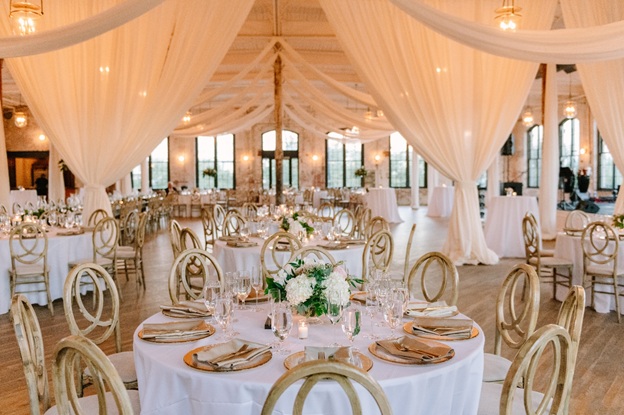
Venue and Major Vendors
One you’ve gotten a handle on the guest number, start working on locking in your date, venue, and the major vendors (caterers, bands, wedding planner, etc.). At Dodeline we are of course huge proponents of having a wedding planner in your corner as soon as possible in the process – the expertise a planner can share with you will save you from making any major mistakes with booking vendors and venues. For example, often people aren’t thinking about things like needing to bring in chairs and tables to one venue and not at another.
Once the major players are in place, look at stationers. We love to talk to clients early in the process, of course, but as we are more able to take multiple weddings per weekend than, say, a band, it’s not usually as urgent to get the stationer locked in as some of the others.
Colors and Style
What’s your vision? People will be asking you that constantly! That said, the custom wedding invitations vision is very much an evolving picture for most clients. Throughout the process you’ll fall in love with different ideas and pieces and eventually they all come together to form the perfect day. We do usually try to incorporate the look and feel into the wedding stationery, so it’s good to have a basic idea to share with your wedding invitation designers. Don’t sweat it if your vision changes slightly from the save the date to the invitations to the wedding day paper though – that is totally okay!
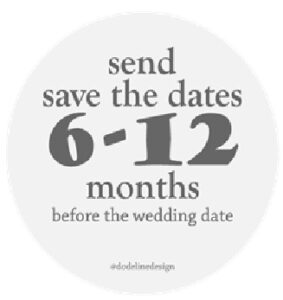
Interested Parties
Who gets a say? This question applies to all facets of the wedding, but it is a good idea to establish that relative to wedding stationery for sure. Remember that on a wedding invitation it is customarily the parents of the bride inviting the guests. While you don’t have to figure that out immediately after getting engaged, just keep in mind that the groom’s parents may expect to be on the invitation (whether that’s correct or not), step parents may be involved, etc. It’s a good idea to know who will be going on the invitation (if anyone other than the bride or groom) and who gets to have input on the design and format. Wording is covered in more detail below.
Budget
The least fun part of the process! Wedding stationery is usually about 5% of a wedding’s overall budget. However, it depends on your priorities. For some people, stationery is one of their all time favorite things, so they may prefer to save a little somewhere else to go all out on invitations. For others, it’s not as big a priority.

Another important note is that, if you choose to do a seated dinner, you’ll be spending a little more on stationery than those who don’t most likely. You’ll need to assign tables and probably seats and that will involve stationery of some kind.
Save the Dates
Design Options
More often than not, we keep it simple with the save the dates. For awhile, it was quite popular to send save the dates as a postcard. While we love the idea in theory, we always want to make sure you realize that the cards will likely be a bit beat up when they get to your guests and that is sometimes disappointing. Postcard do have the advantage of costing less to mail, but it’s not a huge savings.
Photo save the dates are also very popular. When you take beautiful engagement photos, you want to show them off! At Dodeline we work with photo save the dates all the time, but we also do lots of other things like watercolor wedding maps, scenery inspired designs, and more. The sky’s the limit!
It’s nice to start establishing the look and feel of your wedding with the save the date card, so we try to select fonts that you think you would be happy to continue using and/or introduce the colors of the wedding. A fun colorful envelope is always a nice touch and fun for guests to receive in the mail.
When to Send
We recommend sending save the dates any time between 6 months to 1 year before the wedding. A lot of times people think more notice is better and send even further out. While that is somewhat true, it’s important to remember that your guests have busy lives and lots of things happening, so sending them an invitation to something 18 months in the future is probably hard for them to remember or keep up with. Sending inside a year is perfect because they can make actual plans, book hotels, know their own schedules a bit better, etc.
The one exception to this timing is if you’re inviting guests to an international destination and you know that many of them would need to acquire passports. In that case, we would bump the timeline up to inside 15 months.
What to Include
The save the date is just that – minimal information to save the date for your wedding. Typical wording looks something like this:
Save the Date
for the wedding of
Couple’s Names
Date
City, State
For more details, please visit www.dodelinedesign.com
Formal invitation to follow
Variations include:
- Save Our Date
- Save the Date for our Wedding Weekend
- Save the Weekend
- Kindly Save the Date
- Please Save the Date
- And more, feel free to be creative!
Sometimes we will also include a list of hotel blocks or suggested hotels on the back of the save the date. In Charleston, for certain weekends we will add additional verbiage letting guests know that it’s a particularly busy time and they should book early. For example, College of Charleston graduation weekend, the bridge run weekend, and more.
Wedding Invitations
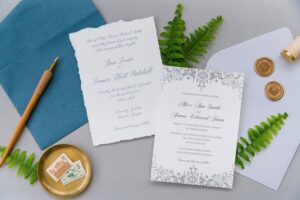
What to Include: Invitations
The invitation is usually the star of the package and includes the formal, traditional wording (or fun wording, you decide!) letting guests know who is getting married, when, and where.
What to Include: Response Cards
There’s a growing trend of having people RSVP online. We are often asked for the pros and cons of the traditional mailed-in option versus online. Here’s how we see it:
| Traditional Mailed RSVPS | Online RSVP |
|
Pros:
Cons:
|
Pros:
Cons:
|

What to Include: Details Cards
Clients often ask us for a template for details cards, but unfortunately, we just really can’t provide that as it’s different for every wedding. We can definitely give you some ideas about what might be on this card, though. Examples might be:
- Hotel Accommodations (whether blocks or just suggestions)
- Directions (especially if there’s anything tricky about the venue location / where to enter / etc.)
- Reception information if you didn’t put that on the invite & it’s a different location than the ceremony
- Maps (often makes it a double sided card)
- Website
- Transportation information if you’re providing it
- Parking information if needed
- Attire
- Additional weekend events
- Suggestions on where to eat / what to do in the wedding city
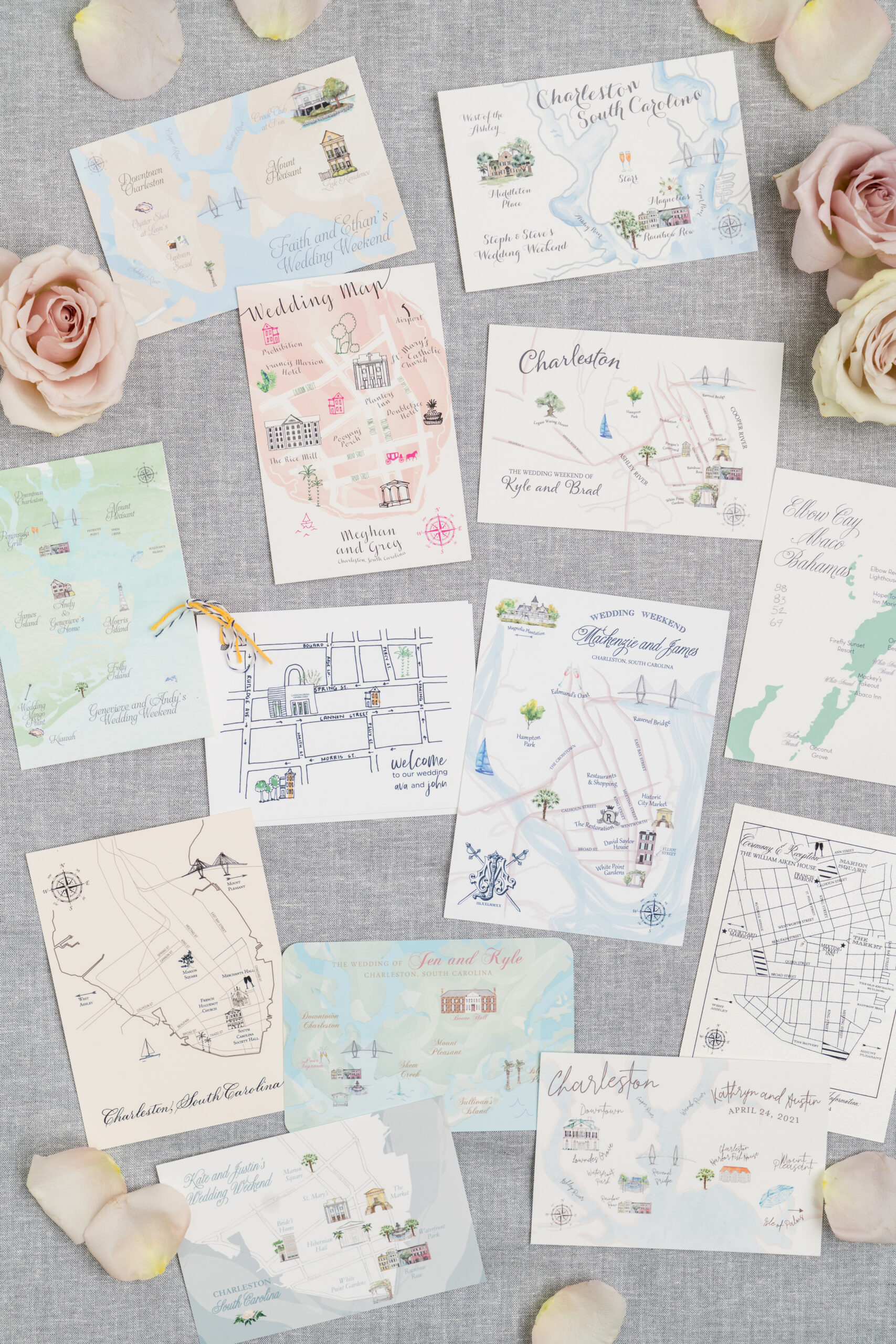
What to Include: Additional Events and Parties
One of the things we do a lot for our clients is incorporate the additional events into your wedding package. Especially for destination weddings, this setup is really nice for your guests because they get all the information at once.
But what if all your guests aren’t invited to each event?
For us at Dodeline, that’s not a problem. Custom wedding invitations are all we do! We can create two versions of your response card and details card so that your guests receive the information they need. So for example, one guest might receive a details card that lists the rehearsal dinner and a response card that lists it as well. Another guest might receive a details card that has a welcome party or perhaps no additional events at all and a corresponding response card.
When we include the additional events in the package, we usually do keep fonts and style roughly the same. So sometimes, if a client really envisions something totally different for the rehearsal and/or welcome party, we do send it separately so it can have a completely different feel. Think barbeque rehearsal but black tie wedding.
Also, they are sometimes sent separately because the hosts want to control their own event and monitor RSVPs, etc., and that’s totally okay too. We just like you to know all the options!

Printing Types and Styles
It seems so simple – just pick out invitations! Wedding invitation card design is much more complex than that, though. Do you like really heavy paper? Raised print? Shiny print? Lots of colors? One color? All of these considerations play into the type of printing you would use which in turn determines the cost. Because it can be hard to really see the difference in a photo (it’s much more of a tactile thing), we’re always happy to send out some samples (request them here). But in the meantime, we’ll do our best to explain the differences and what to expect.
FLAT PRINTED INVITATIONS
For full color designs (think watercolor), flat printing is pretty much the only option. You can use a variety of papers with flat (digital) printing but there is a limit as to how thick those papers can get usually. Flat printing can also be combined with other more specialty options so that you can have the best of both worlds.
Generally speaking, flat printing will be the most economical printing type you can go with.
THERMOGRAPHY
Thermography is a raised print option that offers a wonderful tactile feel. Because of the way the process works, the printing has a slight shine to it. Also using Crane stocks, it works best for simple text designs. This print option will not work well with watercolor looks, large washes of color, or designs with more than two colors.
ENGRAVING
Another truly timeless option, engraving was the most popular invitation printing type for much of the 20th century. It works best with traditional colors like gold or black and offers a raised feel. Unlike thermography, you can actually see the impression of the engraving on the back of the cardstock.
LETTERPRESS
The most timeless of all the printing options, the design is pressed into the paper with letterpress printing. Because of the way the process works, we can use a very heavy paper stock (220# Crane) with letterpress that isn’t available with the other printing options. If you don’t like the super heavy paper, though, we can still use the 110# option from our other printing selections. Often, we letterpress an invitation and use flat printing for the accompanying pieces to save a bit on cost and also to make the invitation the “star of the show.”
Like thermography, this option doesn’t work well with large washes of color, multiple color designs (more than two or three), or watercolor looks. There are ways to combine printing types to create these looks, though!
FOIL PRINTING
Are you all about shine? Then foil is the way to go! Foil printing literally is that – not an ink, but actual foil pressed into the paper with heat or pressure. To achieve a shiny gold, silver, rose gold, etc. – you need to use foil printing.
A side note: often, when you see gold foil invitations online, they are foiling a standard element, which is why the pricing seems low. When you want to foil something particular to you, like your names, a special plate has to be made in order for that to be done, so the cost is higher for truly custom wedding invitations.

Specialty Options
A traditional wedding invitation design package includes an invitation and a response card with the response envelope, inner envelope, and outer envelope. These days, though, the design and structure of a wedding invitation is truly all over the map. Everything from sending invitations in a special box to laser cut elements to vellum wraps to wax seals – if you can dream it up, you can probably do it for your wedding invitation.
Here’s a rundown on just a few of the options about which you might have heard:
- Deckled edges: this is where the invitation edges are torn as opposed to cut straight. It provides a very old fashioned, artisanal feel.
- Laser cutting: laser cutting enables you to create intricate, lace-like pieces. It can be done on the invitation itself, on a pocket around the invitation, a belly band, and more.
- Die cuts: if you’re interested in having the invitation or some of the ancillary insert cards be in a shape of some kind (round, scalloped, etc.), a die cut would need to be used.
- White ink: if you think about it, you’ve probably never used a printer that had white ink. It requires a special type of printer and therefore is usually an upcharge. You need to use white ink to print on dark paper, like navy or emerald green.
- Acrylic wedding invitations: another option that has become more popular recently is screen printed acrylic invitations. They aren’t paper at all! 😊
- Wax seals: adding wax seals to your invitation suite is another way to add a tactile element. They come in a huge variety of colors and can be ordered pre-made or you can get out the glue gun / lighter and make them by hand. Use caution if you plan to put them on the outside of your envelopes, though, as it is very possible they will get ripped off during the trip through the mail. We usually like to put them on belly bands or ribbon inside the envelope. Another important note: double & triple check your postage! Wax seals can sometimes up that cost significantly.

Etiquette & Wording
Society in general is much more relaxed these days so a lot of the etiquette rules have been lightened up a bit. That said, as wedding invitation designers with over a decade of experience, the one rule that we think is non-negotiable is…
Do not put your wedding registry or mention gifts at all in your invitation suite.
Even mentioning “no gifts” implies that you expected they would be bringing one. A wedding invitation is an invitation to share your company on an important day in your life. While gifts are often a part of that, it shouldn’t be part of the information you’re sending it. It comes across a bit like an invitation to purchase a gift for the sender.
As far as the wording of the invitations goes, there are some basic “formulas” you can follow. The most traditional is…
Mr. and Mrs. Bride’s Parents
request the pleasure of your company (non-religious venue)
OR request the honour of your presence (house of worship)
at the marriage of their daughter
Bride’s First & Middle
to
Groom’s First, Middle and Last
Wedding date (all spelled out)
Time
Venue
City, State
Reception to follow / Reception immediately following / dinner & dancing to follow
(if applicable) reception location
*The reception can also be listed on another card entirely. If you do that, you omit the last line completely (so the invitation wording ends with the ceremony city and state).
**the groom’s parents are not listed unless they have financially contributed to the wedding itself (not the rehearsal dinner).
Other variations include:
Including everyone / omitting actual names of parents
Together with their families OR parents
Bride or Partner’s First, Middle and Last
and
Groom’s or Partner’s First, Middle and Last
request the pleasure of your company (non-religious venue)
OR request the honour of your presence (house of worship)
OR invite you to celebrate at their wedding (or many variations thereof)
Wedding date (all spelled out)
Time
Venue
City, State
Reception to follow / Reception immediately following / dinner & dancing to follow
(if applicable) reception location
When the couple is hosting:
Bride or Partner’s First, Middle and Last
and
Groom’s or Partner’s First, Middle and Last
request the pleasure of your company (non-religious venue)
OR request the honour of your presence (house of worship)
OR invite you to celebrate at their wedding (or many variations thereof)
Wedding date (all spelled out)
Time
Venue
City, State
Reception to follow / Reception immediately following / dinner & dancing to follow
When you want to list groom’s parents as well:
Version one
Mr. and Mrs. Bride’s Parents
and Mr. and Mrs. Groom’s parents
request the pleasure of your company (non-religious venue)
OR request the honour of your presence (house of worship)
at the marriage of
Bride’s First Middle and Last
to
Groom’s First, Middle and Last
Wedding date (all spelled out)
Time
Venue
City, State
Reception to follow / Reception immediately following / dinner & dancing to follow
(if applicable) reception location
Version Two
Mr. and Mrs. Bride’s Parents
request the pleasure of your company (non-religious venue)
OR request the honour of your presence (house of worship)
at the marriage of their daughter
Bride’s First & Middle
to
Groom’s First, Middle and Last
Son of Groom’s Parents
Wedding date (all spelled out)
Time
Venue
City, State
Reception to follow / Reception immediately following / dinner & dancing to follow
(if applicable) reception location
When a Parent is Deceased
This is a particularly difficult question but one our clients often face. There are several ways to address the situation. The easiest is often to go the “together with their parents / families” route because it omits names entirely.
If you want to include names, you can choose to add “and the late” in front of the deceased parent’s names, or sometimes we will do “and on behalf of” for the deceased parent. i.e. Mr. Michael Jones and on behalf of Mrs. Sherry Jones
The challenging aspect of honoring a deceased parent is doing so in a way that doesn’t over shadow the joy of the occasion. For that reason, sometimes couples choose not to mention the person on the invitation and instead write a thoughtful passage in the wedding program or include them on a memory table at the wedding.
When Kids are Not Invited
This question comes up a lot in our client meetings. The first thing we encourage couples to consider is how many people on the list this truly affects. Often once they think about it our couples will realize it’s only a few families to whom this rule applies. In that case, we hate to put it in the invitation but instead recommend discussing with the families themselves.
First of all, guests are supposed to know who is invited by how you address them anyway. If it simply says Mr. and Mrs. Bob Smith, their children are not invited. However, some guests overlook that. If you find that you need to clarify further, you can say something on your details card like “We love your children, but we are hosting an adults only event. We are happy to provide suggestions for childcare if needed.” That statement could also go on your website and not in the invitation if you prefer.
Another method is to add a line on the response card that says “number of adults attending” so there is nowhere to list children. Subtle but does the job!
When to Send Wedding Invitations
Earlier is not always better!
In the last few years there has been a trend of clients wanting to send invitations further and further in advance of the wedding date. In reality, there’s a balance to be struck here between giving people plenty of time and not giving them too much time.
For example, do you know what your life will be like in 18 months? It’s hard to send a guest something that far out and expect them to know for sure whether they can attend – one example we like to give is they could not be pregnant on receiving the invitation and have a 3 month old newborn by the time the wedding rolls around! 😉
The typical wedding stationery timeline is:
Save the Dates: any time between 6 months and 12 months before the date
This way, they are actually able to look into flights and hotels, see what their time off options are, etc.
Invitations: 6 – 10 weeks before the wedding date
Close enough that they won’t forget about the big day and also that they can give you a pretty reliable answer as to whether they are coming. On your side, close enough that you should be officially final on things like menu, times, ancillary events, etc.

Addressing Options
Traditionally, wedding invitations were always hand addressed, whether by the mother of the bride or a calligrapher. While nothing can compare to the artistic quality of calligraphy, we have found that most clients opt for printed addresses these days. With the endless options for color and typography, it is a more economical choice that still looks quite beautiful.
The one limitation it’s important to note for printed addresses is you can’t really do metallic inks. So if you are looking for a shiny gold feel, calligraphy is your best bet.
Wedding Day Paper
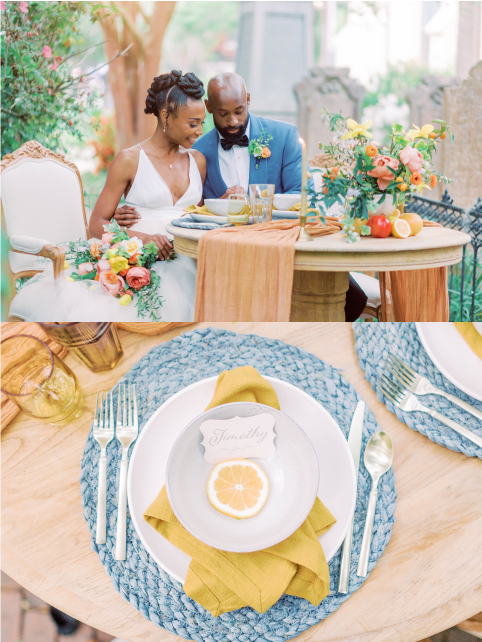
People often assume that wedding stationery only involves the save the date and invitations; however, there’s a whole other category of wedding paper you’ll need to plan for.
Wedding day paper (or “day of paper” as we often call it) includes but is not limited to:
- Ceremony Programs
- Menus
- Place Cards
- Escort Cards
- Seating Charts
- Custom cocktail napkins
- Koozies
- Welcome Bag Itineraries
- Welcome Bag tags
- Signage
- and much more!
To really add that final layer of polish to your event, fully considering the stationery is important. Carrying through a design element like a custom crest to little signs placed throughout (“Cards & Gifts” / Bar Menu / etc.) really takes the whole event up a notch.
Not only does wedding day paper add an aesthetic benefit but it also serves a functional purpose. If you are hosting a seated dinner where guests pre-selected their entrees, you will need to get each guest to the correct seat. To do that, you would have some combination of the following:
- An escort card that says “Ms. Talia Smith” “Table Two”
- A seating chart that lists all guests with their table assignments
- Individual sheets that list the guests at each table that can be tacked up on a mirror or window
- A place card at the seat that says the guest’s name
- A menu with the guest’s name at the top so they know what they are eating as well as where to sit
It’s important to remember when deciding your wedding menu that it’s not only about the food – doing stations doesn’t require you to assign seats or even tables, but seated dinners typically do. Therefore, there is some added expense and effort involved to a seated dinner.

Thank You Notes
Make sure that at some point in time in your wedding stationery process you order thank you notes. These can match your invitation style or be something totally different if you’d like. You can choose to have simple cards that say “Thank You” or they could be personalized with your new married name, a monogram, and more.
Guests who attend your wedding take time and money out of their busy lives to do so, and that should definitely be acknowledged. Get your thank you notes sent out in a timely manner – ideally within 3 months of the wedding. They should be handwritten and include a thoughtful message.
In Conclusion
Here at Dodeline, we’ve been designing, printing, producing and creating wedding stationery for well over 10 years. We’ve seen it all! While we’ve tried to cover all the nuances and details of the wedding stationery process in this article, there are always other ideas and situations to cover. Reach out to us at info@dodelinedesign.com or comment below if you have questions we can answer.
And as always, if you’re looking for an experienced and creative luxury wedding invitation company, we’d love to hear from you.

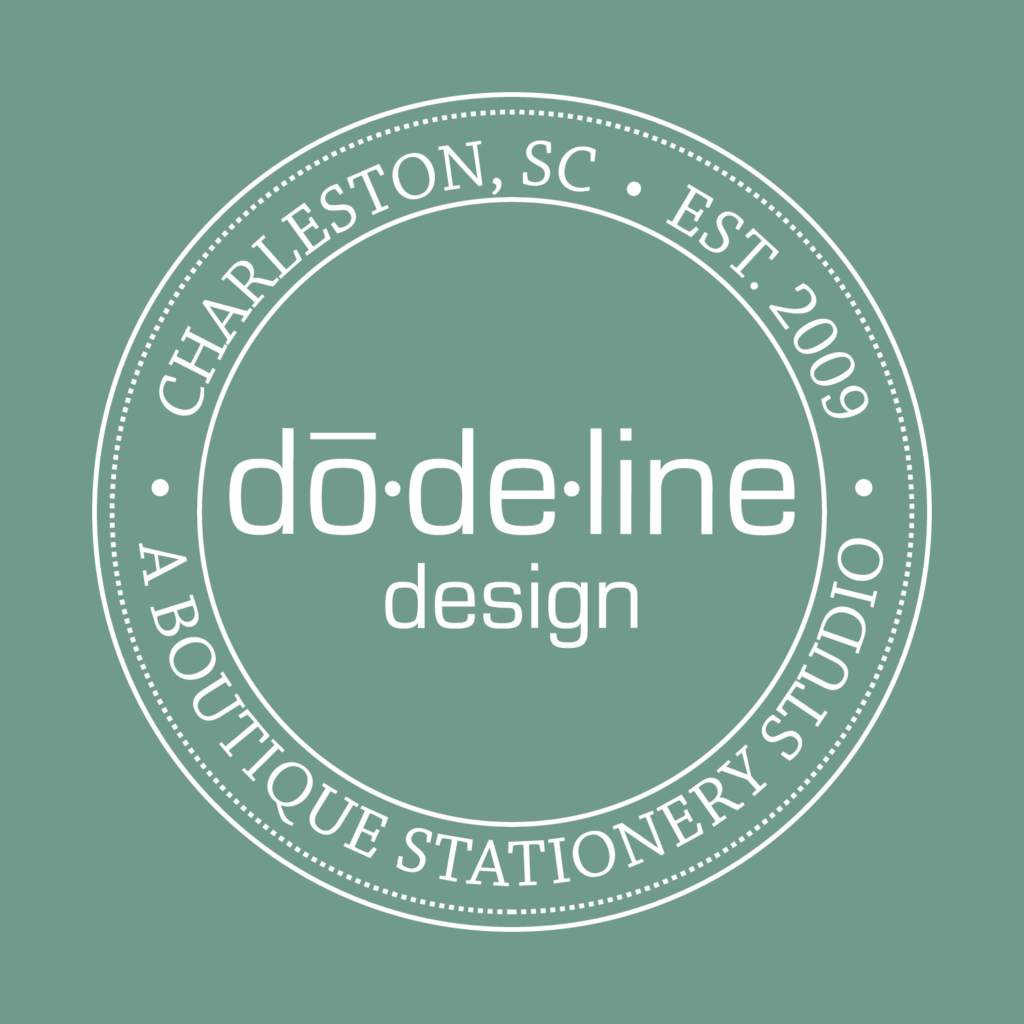


Leave a Reply